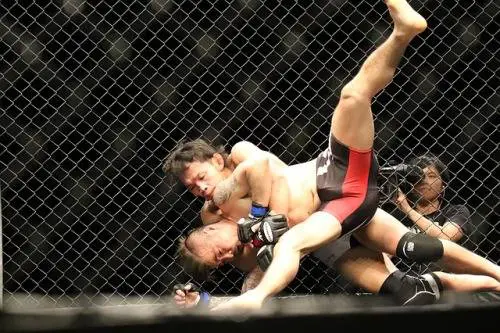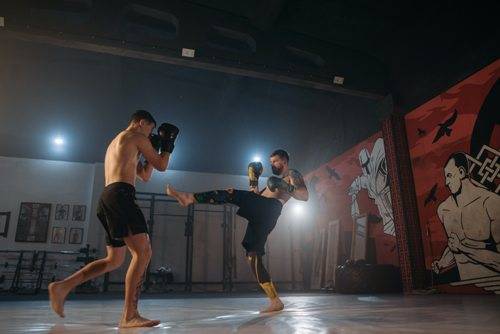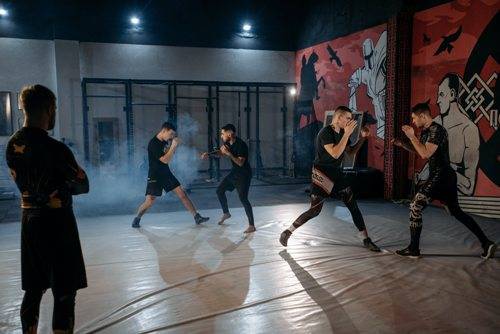
MMA has become more and more popular nowadays for its stress-release and weight loss effect. Many people admit that by training MMA, they are stronger, healthier, and even less stressed.
Therefore, with such amazing influences, many people have changed their minds from learning amateur to becoming professional MMA fighters. In this article, let’s learn how to become a MMA fighter.
Contents
How To Become A MMA fighter
Decide The Martial Arts to Practice

MMA is the name of the combat sport that involves grappling and fighting. In fact, there is no unique “technique” for MMA.
To be specific, MMA fighters advance the curriculum according to applying skillsets and theories of other types of martial arts, such as Jiu Jitsu (BJJ), Muay Thai, Karate, and so on. When training MMA, learners have to choose a martial art to train first to have basic combat skills and knowledge.
However, suppose you are new to the martial arts world either; how to know which martial art is suitable to you? In fact, there are lots of people, especially young adults, who come to MMA training for leisure. So, let us briefly introduce some martial arts to you.
Boxing, kickboxing, and Muay Thai can provide you with basic hand and footwork movements, as well as combat skills. Meanwhile, Karate and Kung Fu trains you in preciseness and responsiveness. Wrestling introduces simple-but-striking hits that make your opponents impossible to defend.
Judo builds the basic combat skills and footwork as well as other martial arts mentioned above, but they also help you gain better posture. Finally, the Brazilian Jiu Jitsu (or shortly, BJJ) is one of the best martial arts in body control and ground defense.
According to our experience, we advise you to take Muay Thai and BJJ as the main training course, but you should also learn boxing for additional skills acquired in the spare time. You will become a well-rounded fighter with knowledge in body control, defense ability, hand, and footwork by such an option.
Make The Training Plan
Typically, there are two main paths in training MMA – you can be an expert in one field or be a generalist in many tasks at a time. Both ways can provide fighters a ticket to the professional world, but they should choose the path that fits their learning ability and health status.
To be specific, many successful MMA fighters are experts in only one martial art. In other words, they are unbeatable in that skill. But if their competitor attacks other skill sets from their un-expert martial arts, they may struggle.
In contrast, generalists who are interested in every martial art also have their pros and cons. Contrary to the “expert” type, they can react well to any movements. However, it’s challenging for them to set up their own “branding” (or “identity”) in the professional world. Typically, MMA trainees who want to go professional won’t choose this path, but only amateurs.
So, it’s your choice to choose to be an expert or a generalist. If you choose to hone one skill, then spend more time and priority on that skill set before moving on to others because others are just complimentary for the main martial arts.
On the contrary, suppose you don’t desire to go professionally, you may choose to learn two sets at a time. There is no need to go serious if you are playing MMA just for fun.
Choose The Training Center and Instructor

After deciding on the martial arts to start and the training plan, let’s find the training center and instructor to start your MMA journey. Most trainees admit that they prefer learning from instructors that are experts in the martial arts than the MMA fighters themselves.
Therefore, we recommend searching for gyms or training centers that are reputable for martial arts training qualification themselves. Besides, many famous MMA centers offer the Muay Thai and Brazilian Jiu-Jitsu combination classes for entry-level learners.
It doesn’t take time to look for MMA gyms on the Internet. However, we recommend you read the reviews on the Internet, then visit the centers directly, and see the actual training space to compare and have the final decision.
Additionally, it would be better if you meet the trainers and discuss your goals, health, and schedule for better consultation with them. Please think carefully about what you want to achieve through the training process. Do you want to go professionally or just play for fun? Are you healthy enough to do this sport, are there any health issues that prevent you from performing?
The more detailed you provide, the better consultation you get. The expert will help you clear up the training path so that you won’t have to throw money down the drain.
Finally, asking the gym whether they provide the trial class for beginner players. Gym memberships are super pricey, so it will be better to try one to two trial classes to decide whether that gym is suitable for your demand.
Prepare Training Equipments

MMA is a combat sport, so it’s a must to prepare some protective gear and equipment before training to protect your body from injuries. In fact, MMA gears are expensive, so we also suggest you ask your instructor (again) for advice on what to buy and where to buy at the best price.
For those who cannot ask for advice from their instructor, let us help you! The most important gear and the first tool to buy before joining the MMA class is protective gloves. In MMA, you have to use your hands to hit, punch, and combat, so it’s impossible not to have injuries. The wound can be more severe for beginners, so please remember to buy high-end, qualified gloves.
Besides gloves, there are some other gears that we highly advise you to buy. For instance, you must have hand wraps (to wrap your hands before wearing gloves), headgear (to cover to top and sides of the head), a mouthguard (in case you get hit at the mouth), and rashguards (for more convenience while learning).
Participate in Competitions
Once your performance has reached its peak, ask your instructor to let you join local events. MMA is a combat sport, so you can only improve their skill when having chances to actually “combat” someone.
As mentioned above, in the MMA community, technique is important but not the top priority. It doesn’t take much time to master the technique, but people prefer gaining experience through real competition.
Therefore, we recommend you to join in many competitions with the attitude of “learning, gaining experience” first. When you are new, never stress on prizes and fame. Think about your contender, their techniques, as well as their strengths and weaknesses.
Most people don’t know that self-reflection is influential for the learning process. After every battle, no matter if you win or lose, spend a little time analyzing your performance.
Are there any moves that make you feel regret? Is there anything you can do better? At which points do your partners do better than you? – asking yourself these questions to have the best reflection and learn to overcome your mistakes in later competitions.
The more battles you join in, the more experience you gain. The more experienced you are, the better you perform.
FAQs
Is MMA a Safe Sport?
When searching for MMA content on the Internet, what we see most are videos of fighters hit and punch each other extremely violently, shaping our viewpoint that MMA is a dangerous sport. However, it is not dangerous, indeed.
Like other sports, MMA demands their players to follow safety requirements not to get injured. If one strictly applies the safety rules and wears protective gear, then you will be safe and sound when doing MMA.
We have to admit that MMA is a sport that includes many “violent” body interactions, but if you have the gears to cover the core body parts like head, joints, face, then the forces you feel from hits will be reduced remarkably.
The only main danger of MMA occurs when you play the sports at the professional level. However, at that stage, most fighters are masters in one type of martial arts, so that they know how to avoid hits and protect their fragile body parts.
In short, MMA is not a dangerous sport. What you should do when starting training MMA is to wear proper protective gear and learn some basic moves to protect your “core” body parts.
At What Age is the Best to Start Training MMA?
There is no perfect age to begin training MMA. However, there is an unwritten but widely accepted rule in sports that the younger you are, the better you can perform.
The younger person has more flexibility, stronger muscles, and responsiveness, so it’s always better to train in sports as soon as possible. But it’s not absolutely right in the MMA world. MMA prioritizes combat and strength, most of which can gain through experience, so if you start MMA late, don’t be worried too much.
Besides, some research has shown that it’s safer to start training in combat sports when the body and the muscles are fully developed.
Just imagine two boxers, one is over 20, one is 12, and they both receive powerful punches from the competitors. Whose bones and joints will crack and take longer to recover? The teenager one will have more cracks, right?
Therefore, we can conclude that the best time to start training MMA is when your body is fully developed or mostly finished puberty, but not too old. So, the perfect age to begin is 15 to 18. To add-in, professional organizations like UFC won’t sign with anyone under 18 so, why start too early?
Read also: Why are heavyweight boxers so tall and How old is too old to start boxing.
Final Thoughts
We have gone through step-by-step guidance on how to become a MMA fighter. Becoming an MMA fighter is a long journey that requires time, effort, and persistence to overcome. However, the result at the end will definitely be worth it. Believe us.
Is our article resourceful enough for your demand? We hope that you could apply our tips to your real MMA training program. Enjoy your practice!

With a passion for combat sports and a wealth of experience, Mike Colon stands as a seasoned figure in the world of martial arts, hailing from the vibrant city of Las Vegas, Nevada. Mike has honed the skills of numerous fighters, guiding them through the intricacies of the sweet science of Boxing and the multifaceted challenges of MMA.
